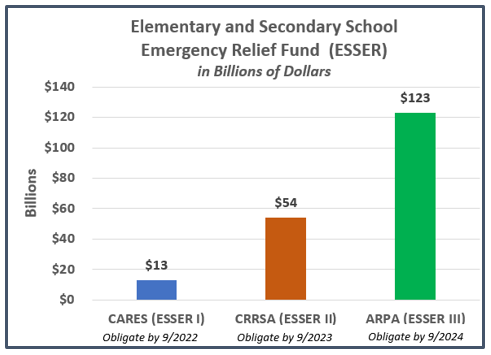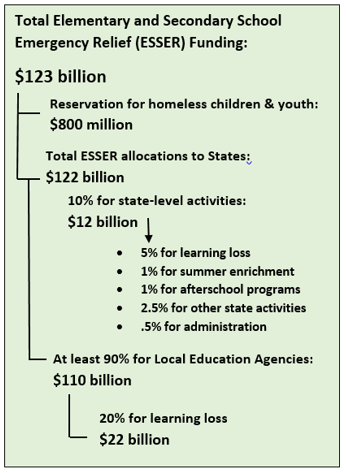American Rescue Plan Act Funds: New Opportunity for Assistive Technology!
The American Rescue Plan (ARP) Act is the third and, by far the largest, federal law providing money to schools to assist with the impact of COVID-19 – known as the Elementary and Secondary School Emergency Relief or ESSER Fund. See graphic below.

The ARP provides $122.8 billion in ESSER funds.
Allocations to states are based on the proportion that each state received under Title I, Part A of the Elementary and Secondary Education Act (ESEA) in the most recent fiscal year. Allocations for each state can be found in this State Allocation Table. Two-thirds of states’ allocations ($81.3 billion) were distributed to the states in late March 2021. The remaining one-third ($40.7 billion) is distributed after submission of a plan that describes how ARP ESSER funds will be used to safely return students to in-person instruction, maximize in-person instruction time, operate schools, and meet the needs of students, and that addresses other requirements of the ARP ESSER Fund. State plans are available here.
States must distribute at least 90 percent of their ESSER allocation to local educational agencies, or LEA also known as school districts. LEAs must spend a certain amount on specific activities as shown in the graphic below.

Each LEA is required to develop its ESSER plan in consultation with stakeholders and post the plan on its website.
Guidance from the U.S. Dept. of Education makes clear that ESSER funds can be used to address the assistive technology needs of students with disabilities. Here are some specifics:
Frequently Asked Questions
An LEA may use ESSER funds for the broad range of activities listed in section 18003(d) of the CARES Act, section 313(d) of the CRRSA Act, and section 2001(e) of the ARP Act including
– Any activity authorized by the Individuals with Disabilities Education Act (IDEA)
– Purchasing educational technology (including hardware, software, and connectivity) for students who are served by the LEA that aids in regular and substantive educational interaction between students and their classroom instructors, including low-income students and students with disabilities, which may include assistive technology or adaptive equipment. (Check out this WIRED article for recommendations on AT for students with dyslexia)
ESSER funds may also be used for:
– Improving the use of technology in the classroom and/or in a remote setting for children with disabilities to enhance learning;
– Software/online/virtual programs, screen capture/recording software, online/virtual cultural curriculum/programs, online/virtual tutoring curriculum/programs, learning management systems;
• Technology accessories, such as headphones, speakers, laptop cameras; and
• Assistive technology devices, such as dedicated communication devices and applications for text-to-speech, graphic organizers, or word prediction.
Additional U.S. Dept. of Ed documents with specific mentions of assistive technology for students with disabilities:
- COVID-19 Handbook V. 2
- Office of Special Education and Rehabilitative Services: Return to School Roadmap: Development and Implementation of Individualized Education Programs (specifically, C-1 and C-2)
As the above document points out, it may be necessary to revise a student’s Individualized Education Program (IEP) in order to address new needs arising from lost instruction due to school closures and remote learning. Such a review/revision should include a consideration of the student’s need for assistive technology devices and/or services.
So …go for it, AT, that is! LEAs have several years to expend their ARP funds. Money should not be an issue when considering the need for AT.
Listen to this podcast with AT expert Dave Edyburn for a discussion of how ARP funds can be used for AT. And read Dave’s updated AT Advocacy article for tips on negotiating AT for students with disabilities.